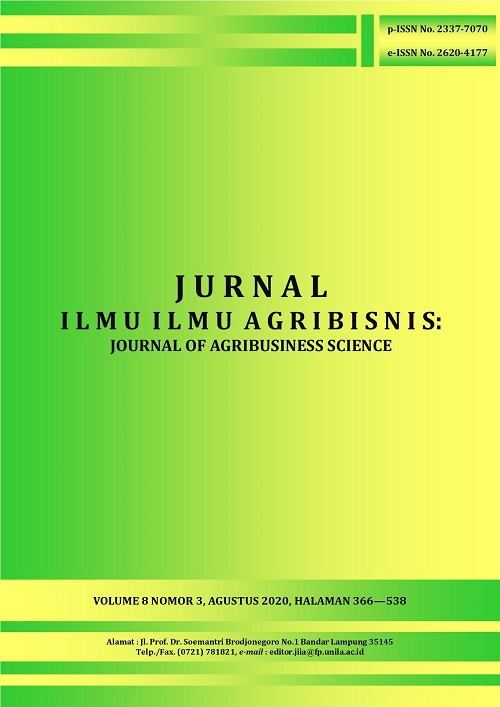POLA KONSUMSI IKAN LAUT DAN FAKTOR-FAKTOR YANG MEMENGARUHI KONSUMSI IKAN LAUT OLEH IBU HAMIL DI KECAMATAN KOTAAGUNG KABUPATEN TANGGAMUS
DOI:
https://doi.org/10.23960/jiia.v8i3.4436 Abstract View: 1095
Abstract View: 1095
Abstract
This study aims to analyze dietary patterns and factors that affect consumption of marine fish by pregnant women in Kotaagung Subdistrict of Tanggamus District. Respondents are 42 women at second and third trimester pregnancies who are recruited voluntarily. Data are analyzed descriptively using Multiattribute Fishbein and multiple linear regressions. The results showed that the consumption patterns of marine fish of pregnant women were illustrated by type of fish consumed, the amount of consumption, frequencies and locations of purchase. The types of fish consumed were cob, flying fish, anchovy, squid, bloated, and blue marlin. The dominant fish consumed by respondents was cob. The average amount of marine fish consumption by pregnant women was 42.12 grams/week and considered very low. The average consumption of protein was 6.02 grams (1.40 %AKE) per day and it was calculated that the maximum desireable dietary pattern (DDP) score for animal food was only 5.60 out of 24 of DDP ideal score. Purchase frequencies of marine fish were once to four times a week. Purchase locations were traditional markets and traveling traders. The factors that influenced the consumption of marine fish were prices of marine fish, pond fish, chicken, and tempeh, income, number of family members, and education.
Key words: dietary pattern, marine fish, pregnant women.
Downloads
Downloads
Published
How to Cite
Issue
Section
License
Authors who publish with this journal agree to the following terms:
Authors retain copyright and grant the journal right of first publication with the work simultaneously licensed under a Creative Commons Attribution License that allows others to share the work with an acknowledgement of the work's authorship and initial publication in this journal.
Authors are able to enter into separate, additional contractual arrangements for the non-exclusive distribution of the journal's published version of the work (e.g., post it to an institutional repository or publish it in a book), with an acknowledgement of its initial publication in this journal.
Authors are permitted and encouraged to post their work online (e.g., in institutional repositories or on their website) prior to and during the submission process, as it can lead to productive exchanges, as well as earlier and greater citation of published work (See The Effect of Open Access).














